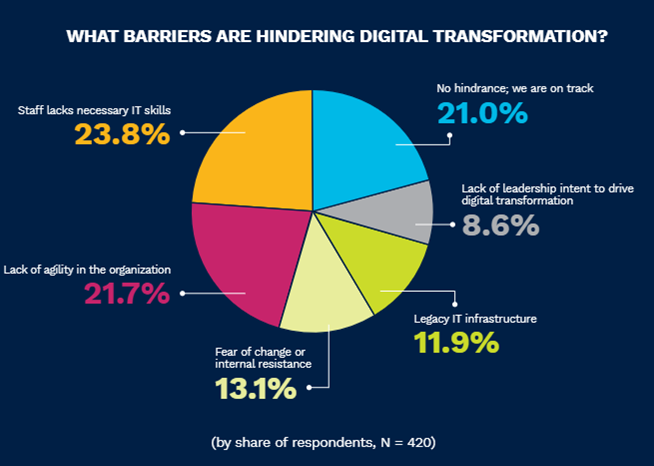Arising at the forefront of digital innovation, the ExitCertified 2023 State of IT Training Report represents a valuable resource for IT leaders aiming to understand how companies approach their IT teams’ training and skill development. In this article, we will uncover the five main takeaways of the report, expanding upon their significance for innovative organizations.
The primary objectives of this report were to acquire a deeper understanding of the techniques IT leadership employs to educate their technology personnel, the actions businesses take to monitor and mitigate the effect of IT skill gaps, and the progression of organizations’ digital transformation journeys. Overall, the report is based on a survey of 420 senior-level IT professionals in the U.S. in a multitude of industries, including IT, financial services, manufacturing, telecommunications, education and government.
Takeaway #1: IT training budgets are expected to grow in 2023

Many enterprises invest in the skills and development of their IT teams. The ExitCertified Report found that over 60% of surveyed companies plan to increase their budget for training in 2023, indicating the high commitment organizations have to supporting their employees’ growth. Approximately a quarter of these companies plan to increase their budget by more than 10%. And it’s not just the big players that are investing in IT training. The report also found that 70% of both large and mid-sized companies said they plan to increase their budget in 2023, compared to just 50% of small companies.
The variables driving budget growth in 2023 are important because they explain why U.S. corporations are increasing their IT training expenditures despite an impending recession. Recessions are usually short-lived and organizations that fail to upskill their workforce find it difficult to tap post-recession growth opportunities. Enterprises that fail to upskill their personnel may struggle to harness post-recession growth possibilities. Forward-looking companies frequently invest more in digital technology before or during an economic slump to remain competitive and strengthen when the economy rebounds. Understanding these dynamics may help IT executives invest in their staff’s abilities and growth.
Takeaway #2: Lack of skilled staff is the most dominant factor hindering digital transformation

It is common knowledge that the digital world is continually changing and companies must be able to adapt to remain competitive. However, 23.8% of respondents said a shortage of trained personnel is the most significant barrier impeding their digital transformation. Surprisingly, the report found that a lack of IT skills was more prevalent in small and mid-sized companies than in large ones. This prevalence may be because established enterprises tend to invest more in their employees’ skills and development, spend significantly more per employee on IT training, and focus more on training their technical staff to bridge IT skills gaps rather than hiring new staff. Hence, large businesses may be less affected by a lack of IT skills in their digital transformation journey.
Having a skilled IT staff is essential for digital transformation. Lacking the right skills hinders meeting transformation project timelines. The report found that 32% of respondents stated their digital transformation initiatives were delayed by six to 10 months due to a shortage of experienced personnel. Conversely, 16% of respondents said their transformation was delayed by 11 to 20 months.
Takeaway #3: Work pressure and budget constraints are among the top challenges in upskilling staff

As the demand for IT skills continues to grow, upskilling the existing workforce has become a key strategy for addressing skill gaps. Nevertheless, IT leaders and L&D teams face several challenges in ensuring their IT teams get the training and certifications they need. Overall, 44.3% of respondents stated that work pressure among IT professionals is the biggest barrier IT staff face, preventing them from reserving time to learn new skills.
The COVID-19 pandemic has also contributed to the challenges faced by IT leaders and L&D teams. The digital boom during the pandemic has resulted in a talent crunch for established companies and startups, making it more difficult to find skilled IT professionals. In addition, budget constraints are another key challenge that can inhibit learning within organizations. More than a third of respondents (37.9%) cited IT training budget restrictions as one of the top challenges in upsklling staff. The digital boom during the pandemic has created a talent bottleneck for established organizations and startups, making it harder to locate experienced IT employees. Budget restrictions might also impede organizational learning. Furthermore, high-pressure work conditions and financial limits are the two most IT training difficulties across firm size, industry (IT vs. non-IT), and operating models. To effectively upskill their IT workers, organizations must address these difficulties and support their learning and development initiatives despite job demands and limits.
Takeaway #4: The skills gap will continue to increase through 2025

Currently, the issue of the skills gap constitutes a major concern for many organizations. Over 50% of IT leaders who participated in the ExitCertified survey predict that the existing skills gap will widen further during the coming years through 2025. This suggests that many organizations expect to face a growing shortage of skilled IT professionals in the near future. However, it’s worth noting that not all respondents shared this outlook since a quarter of respondents (24.5%) indicated that they think there will be no change in the existing skills gap. This could mean that these organizations believe they will be able to keep up with the demand for skilled IT professionals and maintain their current staffing level.
When comparing the results between IT and non-IT companies, the report found that IT companies are more likely to fear that the skills gap will either remain the same or increase in the future. This may be because IT companies are more proactive in formally assessing skills gaps and therefore have a better understanding of their current and future staffing needs. In contrast, non-IT companies may be less aware of their skills gaps and, therefore, less concerned about the potential for a widening gap in the future.
Takeaway #5: IT leaders see an increase in staff productivity after receiving IT training

There are various advantages to investing in technical training for both people and businesses. More than 70% of the 420 companies surveyed observed a significant increase in staff productivity after IT training. More than 60% of the surveyed companies reported that their staff’s job satisfaction increased because of regular training. These results imply that technical training expenditures may favor a range of factors, including product and service quality, productivity, and work satisfaction.
Moreover, increased efficiency might result in other advantages, such as increased work satisfaction and improved customer outcomes. This demonstrates the significance of investing in the skills and development of workers to successfully transform IT. While most respondents recognized several advantages of IT training, around 15% of respondents claimed that higher worker productivity was the sole benefit they observed.
Conclusion
Check out the 2023 State of IT Training Report to learn more about how businesses invest in IT training and what advantages they are reaping. This report contains various information on issues, such as training expenditures, the methods firms use to teach IT workers, and the effects of training on productivity and job satisfaction. Whether you are an IT leader trying to improve your team’s abilities or a person curious about the importance of training in the tech sector, our 2023 State of IT Training Report will provide you with insightful information to get the best value from IT training.
Originally published at https://www.exitcertified.com.
